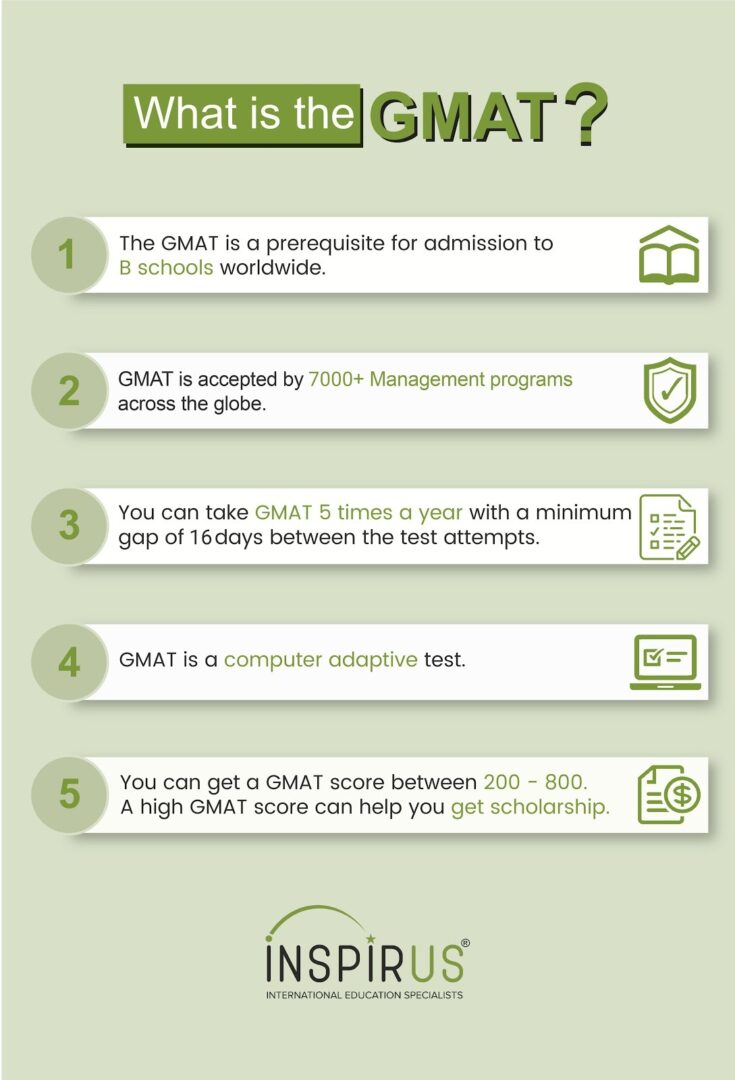GMAT (Graduate Management Admission Test) is around 3.5 hours exam whose score is used by leading business schools across the world for admission to the MBA course. It is a computer-based test and is conducted by GMAC (Graduate Management Admission Council). The exam is designed in such a manner that analyzes the thinking, quantitative, verbal, reading, comprehension, and logical reasoning capability of the test taker to predict how well they would perform in MBA programs.
Table Of Contents
Eligibility For Writing GMAT In 2019:
Below are the eligibility conditions you should meet to write the GMAT exam:
- Age limit: The candidate must be 18 years old. In case, the test taker is 13-17 years old, the written consent of the guardian has to be uploaded. There is no upper age limit for taking the exam.
- Nationality: Since GMAT is a globally conducted and accepted examination, there are no restrictions on nationality.
- The number of attempts allowed: The GMAT exam can be taken a maximum of 5 times only by the candidates in a year. There must be a minimum of 16 days gap between consecutive attempts. However, there has to be a gap of at least five years if the candidate has scored a perfect 800 on the exam.
GMAT Exam Registration:
Candidates can register for the GMAT exam anytime during the year by either of the following modes of registration:
- Online mode: By creating an account on the official website of GMAC.
- Offline mode: By posting the form along with registration fees to the concerned authorities at least ten days before the chosen GMAT date.
- Phone: Contact the GMAT customer service in your region. An additional fee of USD 10 is applicable when you register via this mode.
Registration Fees For The GMAT Exam:
The cost of appearing for the GMAT exam in 2019 is USD 250 worldwide. You can reschedule your attempt by paying a fee of USD 50. The cancellation fees for the GMAT exam is USD 80. The fees can be paid both via online and offline modes of payment.
- Online: Via debit cards, American Express cards, mastercard or visa card.
- Offline: Money orders and cheques posted to Pearson VUE-GMAT at least ten days before the exam date.
What is GMAT Exam Pattern?
GMAT exam aims to analyze and assess the critical thinking capability of the test taker. It is a computer adaptive test (CAT), which means the difficulty of questions is adjusted as per the performance of the test taker.
The following are the highlights of the GMAT exam pattern:
There are a total of 80 questions divided into four sections.
The sections in GMAT exam are-
- Analytical writing assessment- 1 question to be answered in 30 minutes
- Integrated reasoning- 12 questions to be answered in 30 minutes
- Quantitative reasoning – 31 questions to be answered in 62 minutes
- Verbal reasoning – 36 questions to be answered in 65 minutes
In total, the candidate has around 3 hours 30 minutes (includes 8 minutes two breaks) to answer all the 80 questions.
Also Read: How to crack GMAT
What is GMAT Exam – Details Of The Syllabus For GMAT Exam:
| Section | Number of Questions | Duration | Type of Questions |
| Analytical Writing Assessment (AWA) | 1 | 30 minutes | One argument is given- to be analyzed by the test taker |
| Integrated Reasoning | 12 | 30 minutes | Multi-source reasoning, table analysis, graphics interpretation, two-part analysis |
| Quantitative Reasoning | 31 | 62 minutes | Problem-solving and data sufficiency questions |
| Verbal Reasoning | 36 | 65 minutes | Reading comprehension, critical reasoning, sentence correction |
The pattern and syllabus of the GMAT exam have not shown any considerable changes in the last few years. The questions are mainly to the 10+2 level only. The candidates should strictly go through the previous year’s papers to get a fair idea of the exam.
The GMAT exam assesses the candidate using four different sections.
- Analytical writing assessment: In this section, the test taker is given one argument which he needs to analyze and present the possible reasons behind the given case. This section has only 1 question for which the allotted time is 30 minutes. Analysis of argument is what is judged in this section.
- Integrated reasoning: In this section, 12 questions are asked from Multi-source reasoning, graphics interpretation, table analysis, and two-part analysis. The time allotted for this section is also 30 minutes.
- Quantitative reasoning: The main categories of questions in this section are data sufficiency and problem-solving. The questions asked in this section are of 10+2 level only. There has been no noticeable change in the syllabus or type of questions in the past years. So the candidate can get a reasonably good idea about the paper by analyzing the previous year’s papers well.
- Verbal reasoning: This is the most extended section comprising of 36 questions to be answered in 65 minutes. In this section, there are questions related to reading comprehension, critical reasoning, and sentence correction.
GMAT Score:
The score of the GMAT exam is assessed according to the assessment scale devised by the conducting authority of the exam, i.e., GMAC. The score ranges between 200-800 and almost two-thirds of the exam takers score between 400-600.
The scores of GMAT exam section wise are:
- Analytical writing assessment- 0-6
- Integrated reasoning- 1-8
- Quantitative aptitude- 0-60
- Verbal- 6-51
The GMAT score report can be accessed by the candidates as well as schools three weeks after the test is taken. However, a candidate can get an unofficial report which contains the scores of all sections except the AWA. This unofficial scorecard is not acceptable in any institution. It’s just for reference for the candidate to know whether he performed up to the mark or he should retake the test. It also gives him a fair idea as to which schools he can target with the score.
How is GMAT scored?
The scores that you’ll receive are:
- Analytical Writing Assessment (0-6.0)
- Integrated Reasoning (0 to 8)
- Verbal (6 to 51)
- Quant (0 to 60)
- The total cumulative score of Verbal and Quant (200-800)- This is the score that is referred to the most.
The above mentioned are the 5 different GMAT scores that you’ll receive by mail about 2 weeks after you appear your exam.
But, don’t get confused by all the scores. Your total score of GMAT is a combination of the quantitative and verbal scores and it is scored in the range of 200 to 800. And this total score is the score that is always considered.
Now, let us take a look at how these scores are actually calculated.
1. Analytical Writing Assessment Score:
The analytical writing score is assessed separately on a scale of 0 to 6. Your essay gets scored twice, once by a human reader and once by a computer. The average of the two scores is calculated and that is your final AWA score.
For example, if you score a 5 when scored by a human reader and a 4 when scored by a computer, your total score will be the average of the two scores i.e. a 4.5.
2. Integrated Reasoning Score:
The integrated reasoning section consists of a total of 12 questions. Out of the 12 questions, 3 questions are experimental; meaning that, the score of these 3 questions won’t be calculated. However, there is no way to tell which question is experimental and which question is not. Hence, you must try to do your best on all the questions without worrying about which question is experimental.
So, your score gets calculated based on the remaining 9 questions which are non-experimental. For example, if you answer 7 out of 9 questions correctly then 7 out of 9 is your raw score. This score is then scaled on a range of 0-8; giving you a final score of maybe a 6 or a 7.
3. Verbal and Quantitative Section Score:
The verbal and quantitative sections of the GMAT are both scored on a scale of 0-60 separately. Your raw scores are converted to scaled scores to obtain scores in the range of 0-60.
4. Your Total GMAT Score:
Your total GMAT score ranges between 200 and 800 and it is cumulative of your verbal and quants scores. How your scaled scores of quants and verbal get converted to form your final/ total score depends on the following 3 factors:
- The number of questions answered by you.
- The number of questions that you answered correctly.
- The difficulty level of the questions answered by you.
The above factors are taken into consideration and using this, the GMAC computes your total GMAT score.
The Validity Of The GMAT Score:
The GMAT score is valid for up to 5 years. The test takers have the option of retaking the exam maximum five times in a given year. The GMAT score is used to procure admission in leading business schools. However, some recruiters also utilize the GMAT score for providing jobs to the candidates.
Some of the leading business schools in India which accept GMAT score for admission to their prestigious MBA program are:
1.Indian School of Business (Hyd and Mohali)
- Indian Institute of Management
- Great Lakes
- XLRI
- MDI Gurgaon
- SP Jain School of Global Management
- SP Jain Institute of management and research, and many more
How Important Is The GMAT Score To Get Admission In A Good Business School?
All leading business schools accept GMAT scores for admission to their management programs. The GMAT scores are usually used to screen the initial pool of candidates and to rank them in order of preference. Often, a high GMAT score increases your chances of getting into a good school.
However, it is not the sole deciding criteria. There are several other factors that are taken into consideration by the business schools for giving admission to candidates. Business schools trust the GMAT score as a reliable index for making informed decisions during the admission process. GMAT has been used as the most reliable tool for admissions to management courses for more than 60 years now. This has been because the test is designed in such a way to reveal a lot about the thinking, analysis, and imaginative powers of the candidate. It shows their commitment, motivation, and ability to succeed in the real business school environment. Hence, it’s advisable to appear for the GMAT exam if you aim to get admission to a leading business school which will help polish your skills and make you industry-ready.
Know what a good GMAT score is to get admission into your dream university.
Best Way To Prepare For GMAT Exam:
Below are some preparation guidelines which have been devised by experts for the preparation of GMAT exam:
- Plan your preparation strategy well. Give at least eight weeks before the attempt.
- Check the official website of GMAC, mba.com, for test papers and previous year papers.
- Take test reviews and advice from those who have previously appeared for the exam.
- Do not cram the concepts. Understand them well as the exam would be focussed on judging your analyzing capacity more.
- Appear for mock tests.
- Learn to manage your time well.
Here is a guide to help you improve your verbal score on GMAT.
Although the preparation strategy would vary for every individual, these are some standard tips that should be kept in mind. There is no strict formula for success. Perseverance and consistent hard work will surely help you attain your desired score and also an admission to the best B-schools.
We hope this article cleared your doubts about what is GMAT exam. All the best for your exam preparation!



